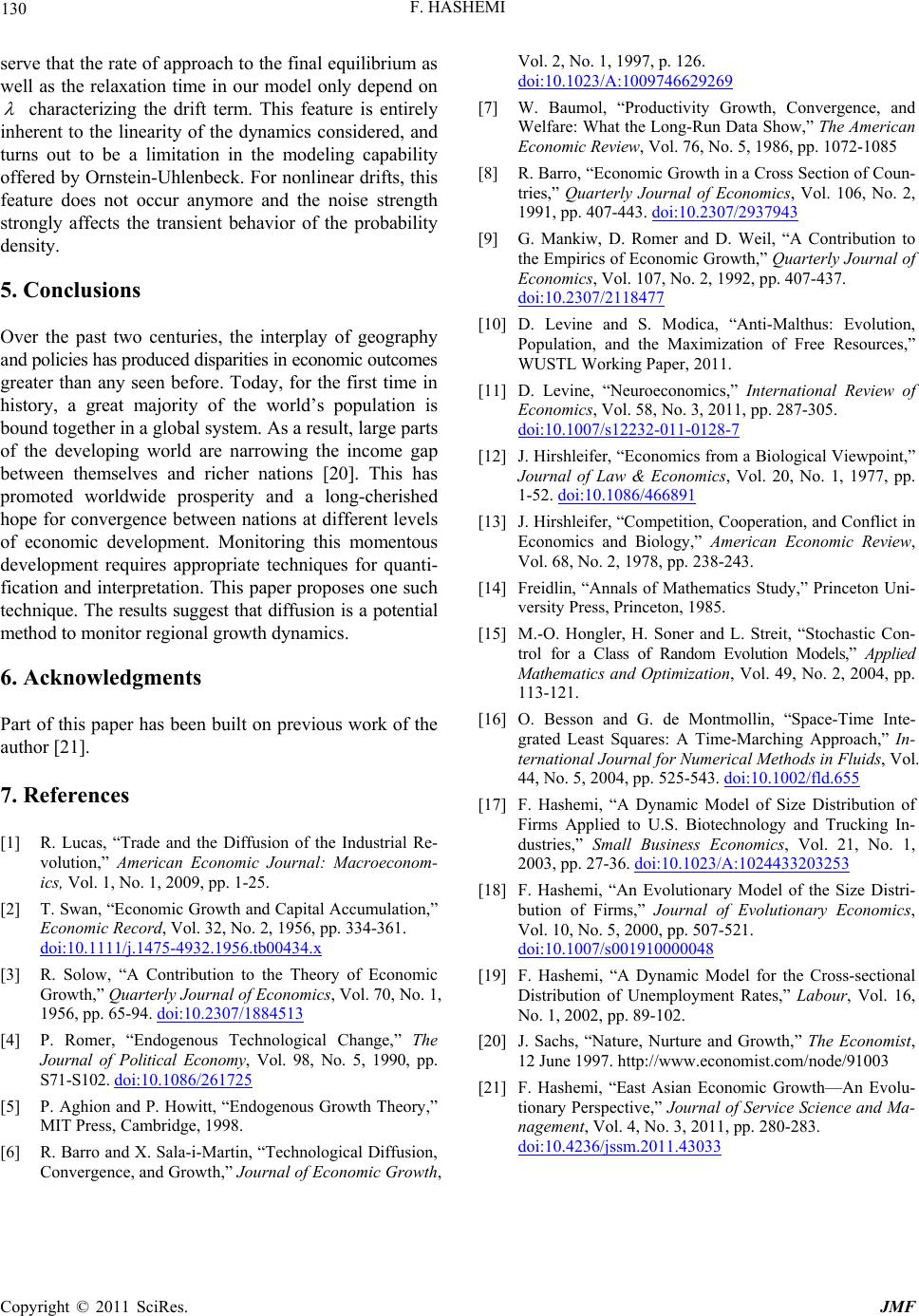
F. HASHEMI
130
serve that the rate of approach to the final equilibrium as
well as the relaxation time in our model only depend on
Vol. 2, No. 1, 1997, p. 126.
doi:10.1023/A:1009746629269
[7] W. Baumol, “Productivity Growth, Convergence, and
Welfare: What the Long-Run Data Show,” The American
Economic Review, Vol. 76, No. 5, 1986, pp. 1072-1085
[8] R. Barro, “Economic Growth in a Cross Section of Coun-
tries,” Quarterly Journal of Economics, Vol. 106, No. 2,
1991, pp. 407-443. doi:10.2307/2937943
characterizing the drift term. This feature is entirely
inherent to the linearity of the dynamics considered, and
turns out to be a limitation in the modeling capability
offered by Ornstein-Uhlenbeck. For nonlinear drifts, this
feature does not occur anymore and the noise strength
strongly affects the transient behavior of the probability
density.
5. Conclusions
Over the past two centuries, the interplay of geography
and policies has produced disparities in economic outcomes
greater than any seen before. Tod
istory, a great majority of the world’s population is
m
[1]
[9] G. Mankiw, D. Romer and D. Weil, “A Contribution to
the Empirics of Economic Growth,” Quarterly Journal of
Economics, Vol. 107, No. 2, 1992, pp. 407-437.
doi:10.2307/2118477
[10] D. Levine and S. Modica, “Anti-Malthus: Evolution,
Population, and the Maximization of Free Resources,”
WUSTL Working Paper, 2011.
conomics,” International Review of
Economics, Vol. 58, No. 3, 2011, pp. 287-305.
ay, for the first time in
h
bound together in a glob al system. As a result, large parts
of the developing world are narrowing the income gap
between themselves and richer nations [20]. This has
promoted worldwide prosperity and a long-cherished
hope for convergence between nations at different levels
of econoic development. Monitoring this momentous
development requires appropriate techniques for quanti-
fication and interpretation. This paper proposes one such
technique. The results suggest that diffusion is a potential
method to monitor regional growth dynamics.
6. Acknowledgments
Part of this paper has been built on previous work of the
author [21].
7. References
R. Lucas, “Trade and the Diffusion of the Industrial Re-
volution,” American Economic Journal: Macroeconom-
ics, Vol. 1, No. 1, 2009, pp. 1-25.
[2] T. Swan, “Economic Growth and Capital Accumulation,”
Economic Record, Vol. 32, No. 2, 1956, pp. 334-361.
doi:10.1111/j.1475-4932.1956.tb00434.x
[3] R. Solow,
Growth,” “A Contribution to the Theory of Economic
Quarterly Journal of Economics, Vol. 70, No. 1,
doi:10.2307/1884513
1956, pp. 65-94.
dogenous Technological Change,” The [4] P. Romer, “En
Journal of Political Economy, Vol. 98, No. 5, 1990, pp.
S71-S102. doi:10.1086/261725
[5] P. Aghion and P. Howitt, “Endogenous Growth Theory,”
MIT Press, Cambridge, 1998.
[6] R. Barro and X. Sala-i-Martin, “Technological Diffusion,
Convergence, and Growth,” Journal of Economic Growth,
[11] D. Levine, “Neuroe
doi:10.1007/s12232-011-0128-7
[12] J. Hirshleifer, “Economics from a Biological Viewpoint,”
Journal of Law & Economics, Vol. 20, No. 1, 1977, pp.
1-52. doi:10.1086/466891
[13] J. Hirshleifer, “Competition, Cooperation, and Conflict in
Economics and Biology,” American Economic Review
Vol. 68, No. 2, 1978, pp. 238-243. ,
hematics Study,” Princeton Uni-
.
tics and Optimization, Vol. 49, No. 2, 2004, pp.
d G. de Montmollin, “Space-Time Inte-
grated Least Squares: A Time-Marching Approach,” In-
[14] Freidlin, “Annals of Mat
versity Press, Princeton, 1985
[15] M.-O. Hongler, H. Soner and L. Streit, “Stochastic Con-
trol for a Class of Random Evolution Models,” Applied
Mathema
113-121.
16] O. Besson an[
ternational Journal for Numerical Methods in Fluids, Vol.
44, No. 5, 2004, pp. 525-543. doi:10.1002/fld.655
[17] F. Hashemi, “A Dynamic Model of Size Distribution of
1,
03253
Firms Applied to U.S. Biotechnology and Trucking In-
dustries,” Small Business Economics, Vol. 21, No.
2003, pp. 27-36. doi:10.1023/A:10244332
[18] F. Hashemi, “An Evolutionary Model of the Size Distri-
bution of Firms,” Journal of Evolutionary Economics,
Vol. 10, No. 5, 2000, pp. 507-521.
doi:10.1007/s001910000048
[19] F. Hashemi, “A Dynamic Model for the Cross-sectional
Distribution of Unemployment Rates,” Labour, Vol. 16,
Growth,” The Economist,
of Service Science and Ma-
p. 280-283.
No. 1, 2002, pp. 89-102.
[20] J. Sachs, “Nature, Nurture and
12 June 1997. http://www.economist.com/node/91003
[21] F. Hashemi, “East Asian Economic Growth—An Evolu-
tionary Perspective,” Journal
nagement, Vol. 4, No. 3, 2011, p
doi:10.4236/jssm.2011.43033
C
opyright © 2011 SciRes. JMF